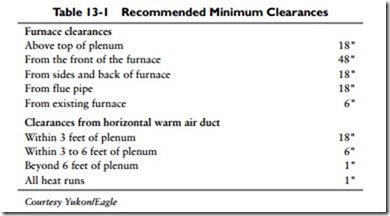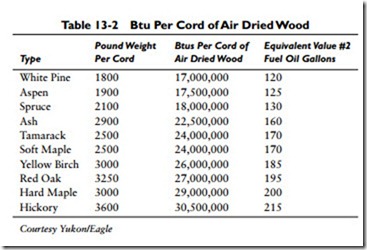Installation, Operating, and Maintenance Instructions for Coal, Wood, and Multi-Fuel Furnaces
Make certain you have familiarized yourself with all local codes and regulations governing the installation, operation, and mainte- nance of coal furnaces and coal stokers, wood furnaces, and multi- fuel furnaces. Local codes and regulations take precedence over national standards.
Assembly and Installation Recommendations
Coal, wood, and multi-fuel furnaces are shipped disassembled with complete assembly instructions. The installer must assemble the furnace in accordance with these instructions. If the furnace is fired by a coal stoker or contains some automatic controls, the installer must connect the electrical service from the line voltage main. The low-voltage thermostat must also be connected.
Caution
NEVER attempt to assemble and install a furnace unless you have the necessary qualifications. Furnace assembly is a task best left to those with the necessary training and experience. It is not a do-it-yourself project. An improperly assembled and installed furnace is a fire hazard and could lead to serious injuries or even death.
Note
Always check the local building codes first before installing a furnace. The installation must comply with the local code requirements.
NEVER install a wood furnace so that the supply air from the wood furnace feeds into the return air of the conventional furnace. Doing so may result in the following problems:
1. Shortened blower motor life caused by high air temperatures from the wood furnace.
2. High temperatures in the return air ducts caused by reverse air flow during a power failure.
3. High temperatures causing the blower to trip off on a thermal overload.
4. Toxic fumes pulled from the heat exchanger and forced into the rooms.
Locate the furnace as close to the chimney or flue as possible and near the center of the heat distribution system (i.e., the ductwork) or next to a primary furnace. Be sure to maintain the minimum clearances specified in the local building code. The NFPA (National Fire Protection Agency) Standard No. 90B also lists and describes the minimum standard clearances from combustible surfaces. Recommended clearances are listed in Table 13-1.
Reduced clearances are permitted if the area between the furnace and combustible ducts are protected according to NFPA Bulletin 90B. In any case, the furnace must be so located that it receives suf- ficient combustion air.
Caution
Shielding a wall with sheet metal or masonry will not protect it. These materials are excellent heat conductors, and any com- bustible wall material behind them will still be a fire hazard.
Maintenance Instructions
Always follow a regular service and maintenance schedule to ensure safe and efficient operation of the furnace. Keep a service and main- tenance list next to the furnace and check off the date of each inspection with comments on what was done.
1. Make certain the duct connections to the furnace are tight and secure.
2. Follow a regular service and maintenance schedule of the fur- nace and chimney for safe and secure operation.
3. Frequently inspect and clean the heat exchanger, smoke pipe, and chimney of soot and/or creosote.
4. Periodically check the furnace cabinet (jacket) for cracks.
5. Make certain all access doors fit tightly.
6. Inspect and clean the air filter monthly. Change the air filter at least twice a year.
7. Regularly inspect and clean the air cleaner grids on furnaces equipped with electronic air cleaners.
8. Periodically clean the humidifier (if so equipped).
9. Oil the blower motor twice a year (blowers with oil caps).
Wood and Coal Furnace Maintenance
1. Remove ash and other debris left over from the combustion process on a daily basis during the heating season.
Note
Never spread ash on your garden or lawn. It contains toxic substances that will kill plants or grass.
Caution
Never allow ashes to build up to the grate level in the furnace. Doing so will shorten the service life of the grate.
2. Keep the heating surfaces and flues clean. Soot will reduce heating efficiency. A dirty furnace requires much more fuel to produce the required heat than a clean one does.
3. Hard clinkers lodged between the grate bars should be removed with a poker or slice bar.
Multi-Fuel Furnace Maintenance
Multi-fuel furnaces, or combination furnaces as they are also called, burn coal or wood with oil, gas, or electricity. Because they burn solid fuels (wood or coal), the maintenance instructions for coal and wood furnaces will also apply to the solid-fuel burning sections of a multi-fuel furnace.
1. Inspect and perform any necessary maintenance on a gas or oil burner at least twice a year, preferably at the end and beginning of the heating system. Gas burner and oil burner service and maintenance is covered in the second volume of the Heating, Ventilating, and Air Conditioning Library.
Caution
Maintaining, adjusting, and repairing oil and gas burners requires special instruments and training. These tasks are best left to a trained HVAC technician or someone with equivalent experience.
2. Remove and clean the oil burner strainer at the end of the heating system.
3. Fill the oil storage tank at the end of the heating season to prevent water vapor from collecting.
4. Lubricate the oil burner every 3 months.
5. Have a qualified HVAC technician check and service the oil burner at the beginning of the heating season.
6. Clean, inspect, and service the furnace, smoke pipe, and chimney at the beginning of the heating system.
7. Check the furnace and burner electrical system before the beginning of the heating system (primary relay, limit control, thermo- stat, electrodes, electrode terminals, and transformer terminals).
8. Clean the solid fuel combustion chamber according to the procedures for cleaning a coal or wood furnace.
Wood and Coal Furnace Operation
Any solid fuel has approximately 12,000 Btu per pound if its moisture content is zero. This holds true for coal as well as any of the woods burned in a furnace. The Btu per cord of air dried wood are listed in Table 13-2. Ignition temperatures of coal and wood are listed in Table 13-3.
Wood Furnaces
The wood burning furnace shown in Fig. 13-13 is designed to allow the primary air under the grate to create the initial burning. As the wood burns, gases containing as much as 40 percent of the energy of the wood rise to the top of the flame. The secondary air system (i.e., the round tubes between the firebrick) draws room air into the tubes and provides oxygen to the firebox to burn these gases before they can escape up the chimney flue. The procedure for starting and maintaining a wood fire in a furnace may be outlined as follows:
1. Open the manual draft spinner three or four turns.
2. Make sure the smoke pipe damper is open.
3. Place several pieces of crumpled paper in the center of the furnace firebox.
4. Place a few handfuls of kindling wood in a criss-cross pattern across the paper, and then add a few pieces of firewood.
Caution
Never start a coal or wood fire with gasoline, kerosene, thin- ners, or any other type of volatile substance.
5. Ignite the paper and close the door to the firebox. Resist the desire to open the door immediately after igniting the paper to see how the fire is doing. Opening the door at this point may cause a flame flash out. It will take a few minutes for the fire to establish itself.
6. Start adding larger pieces of wood when you see some red-hot burning embers. Build the fire slowly. Smaller pieces of wood burn cleaner because they have more surface area exposed to the fire. Use wood a maximum of 4 to 6 inches thick and about 2 to 4 inches narrower than the width of the furnace firebox.
7. Once the fire is established, adjust the draft according to your needs. The draft control on the furnace controls the burning time.
Caution
Always open the door to the firebox slowly. Rapidly opening the door could cause flames to leap out of the firebox.
Coal Furnaces
Burning coal is more difficult than burning wood. It requires patience and a regular procedure. If you are not careful, a coal fire can extinguish itself in a relatively short time. Once a coal fire starts to go out, it is next to impossible to reverse it. If the coal fire goes out, remove all the coal from the furnace and then start the process all over again.
Coal comes in various sizes and types. As a rule, anthracite coal is recommended, because it burns with little smoke when burned properly. Select a coal size that will not fall through the air spaces in the furnace grate. These air spaces are 1⁄2 inch wide, so the coal size must be larger than that. Coal is available in three sizes: pea size, nut size, and stove size. Nut-size coal (13⁄16 to 15⁄8 inch) is recommended for coal furnaces.
How to Start a Coal Fire
1. Place a small amount of crumpled paper and sticks of kindling wood on the ash-covered grates of the furnace.
2. Ignite the paper and wait until the wood starts to burn well.
3. Cover the burning paper and wood with a thin layer of evenly distributed coal. The pieces of coal must touch each other to ignite.
4. Soon after the first layer of coal is ignited, gradually add more coal until the fire bed is built up to about 6 inches deep. As you add the fresh coal always leave some of the burning coal uncovered. Be careful not to smother the fire when adding fresh coal.
5. Draw the top red coals toward the front of the firebox and pile fresh coals toward the back.
Note
Protect the furnace grate from direct contact with the fire by a 1- to 2-inch thick layer of ash. This will help prevent the cast- iron grates from overheating and coal from falling through the grate openings.
How to Maintain a Coal Fire
1. Shake the grates once or twice a day to prevent excessive ash
accumulation on the grates.
2. Shake the grates with a few short strokes and stop as soon as you see red coals appearing in the ash pan.
Note
Shaking the grate too much may extinguish the fire; shaking it not enough may restrict the amount of air reaching the fire.
3. Never poke or break up a coal fire. Poking the fire tends to bring ash to the surface of the coal bed, where it fuses into lumps or clinkers. Clinkers interfere with efficient burning of the coal.
How to Bank a Coal Fire
Coal fires are reduced (banked) during the night, when less heat is required. If you are using anthracite coal, pile the coal higher toward the back of the firebox and allow it to slope forward toward the firebox door. Leave some red or burning coal uncovered in the front of the firebox.
If you are using bituminous coal, shake the fire and add coal, forming the center cone. Allow enough time for the volatiles to burn off before closing the door to the firebox.


